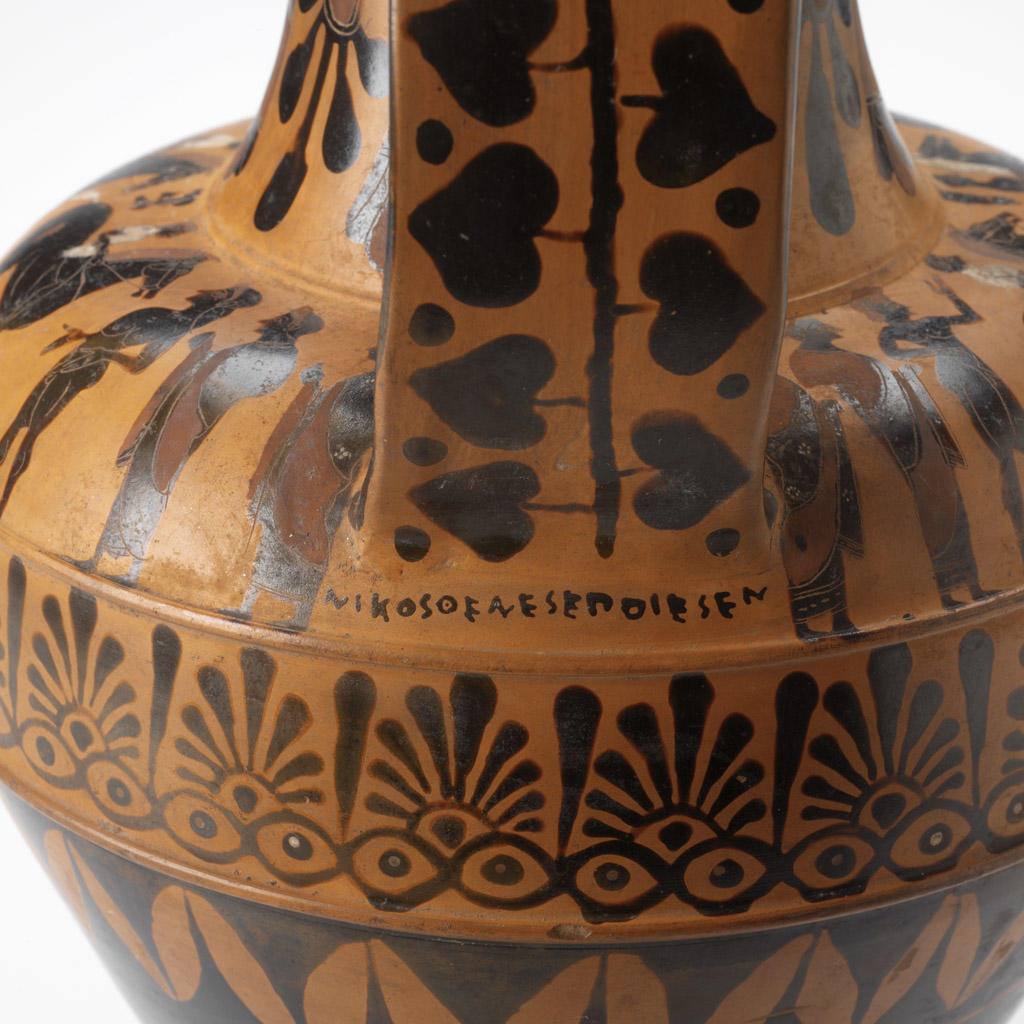Many pieces of ancient art were made to be used. When viewed in the context of an art museum, surrounded by objects generally made for aesthetic purposes, it can be easy to forget how these older works were made with other functions in mind. One vase in RISD’s collection, an Athenian amphora (storage jar), demonstrates how looking at the utilitarian function of pieces of ancient art can inform and complement how we look at them as art objects.
One of the most distinguishing features of this amphora—aside from it being two and a half millennia old and made on the other side of the planet—is that it is signed by the potter. It is inscribed where one of the handles is joined with the body of the vase with “Nikosthenes epoiesen,” which translates to “Nikosthenes made [this].” Potters usually signed with “epoiesen” and painters with “egraphsen,” meaning “drew.” Nikosthenes is the best-attested potter in the black-figure tradition, with 133 known signed vessels, so it’s likely that he ran a rather large workshop. Though he was based in Athens, most of his vases were found almost 1,000 miles away.
The main findspot of Athenian, or Attic, vases is not Athens or even anywhere in Greece, but Vulci, an Etruscan city in the central Italian region of Latium. The rest of the top five are also Etruscan cities: Tarquinia, Cerveteri (where RISD’s was found), Orvieto, and Chiusi. The Etruscans were the dominant power in central and northern Italy at this time (the sixth century BCE). The upper classes of Etruscan society drew their wealth from their role in Mediterranean trade routes, particularly commodity exports, such as the iron abundant in the region. These elites built massive tombs for themselves and filled them with valuable goods, including Athenian vases.
Value can be defined as "worth, desirability, and utility," and thus determining the value of these vases at the time they were made is difficult. While it's very likely they weren't as absurdly prized as they are today—the infamous Euphronios krater, also from Cerveteri, was acquired by the Met in 1972 for $1.2 million (that's $6.8 million when adjusted for inflation)—there is considerable circumstantial evidence that the Etruscans highly valued Athenian vases. Some have argued that ceramic vases were meant to be used in burials as cheaper substitutes for more valuable metal vessels; in other words, Grandpa's never going to know he wasn't buried with the good china. In the rare discoveries of intact Etruscan tombs (most others had been looted in antiquity1 ), however, archaeologists found both precious metals and ceramics, indicating that the value of an object did not preclude it from being buried. Wall paintings in Tarquinia depict scenes of (living) revelers using Athenian vases in banquets and displaying them on kylikeia, or vase cabinets. Furthermore, many of these vases were repaired in antiquity and their fragments are rarely found amongst the masses of coarse local wares in wells and garbage deposits. It's reasonable to say that the Etruscans used and valued Athenian pottery.
A closer look at Nikosthenes and his products reveals that it was no coincidence that Attic ware was so popular in Etruria: Athenian potters were specifically tailoring their wares to Etruscan tastes. RISD’s amphora is actually a classic example of a Nikosthenic amphora. Named for their most prolific producer, these vessels were modeled on earlier forms of Etruscan pottery produced in bucchero, a local ceramic fabric. Bucchero’s glossy black finish was used to replicate metal, and close examination of this amphora’s features—namely the flat, band-like handles, conical mouth, and horizontally ridged body—lets slip the style’s metallic origins. Iconographically, standard Athenian scenes of athletic competitions, battles, and horses would have been popular with the equestrian-oriented Etruscan elite. In addition to amphorae, Nikosthenes is also credited with several other vase shapes. Most of Nikosthenes’s vases have been found in Vulci, but almost all of his amphorae were found in Cerveteri. Nikosthenes, with his works designed to appeal to buyers in specific, distant markets, may very well be the godfather of international marketing.
The miles and millennia separating us from the world in which ancient artists and artisans worked can make it difficult to connect with the objects. This vase and those similar to it reveal what a group of ancient people valued when it came to burying and commemorating their dead. It is unique, however, because so many Greek potters and painters are only known to us anonymously by their styles (such as the Providence Painter, whose most iconic piece is part of RISD’s collection), yet here we have not only a person’s name inscribed on a vase, but a declarative statement: “Nikosthenes made this.” Unlike his contemporaries, we know both his name and something of his nature. He must have had an enterprising and opportunistic streak to capitalize on demands in a certain foreign market, the success of which is attested to by his sheer prolificacy. Nikosthenes’s name and understandable economic motivation is incredibly humanizing: the names, let alone anything of the qualities, of the staggering majority of ancient Greek people are lost to us. By studying ancient objects we try to connect to whole cultures or peoples. This amphora is connects us to an individual.
- 1The fact that these tombs would be looted of precious metals but not painted ceramics further highlights how Attic pottery has only relatively recently become much sought-after.


